Cronkite News has moved to a new home at cronkitenews.azpbs.org. Use this site to search archives from 2011 to May 2015. You can search the new site for current stories.
Releases from Glen Canyon Dam aim to improve Colorado River
WASHINGTON – The Interior Department said it will test high-volume water releases from the Glen Canyon Dam in an effort to simulate natural flooding and improve sediment flow through the Grand Canyon.
Interior Secretary Ken Salazar also announced Wednesday that the department will remove and relocate, rather than destroy, non-native fish species in the Colorado River as part of a long-term study on the river.
“We’re protecting one of world’s most treasured landscapes,” said Salazar, who called the Colorado the “lifeblood” of the region for the water and power it provides.
Under the plan unveiled Wednesday, the department could begin releasing high amounts of water from the Glen Canyon Dam as early as this October to enhance sediment levels and help restore beaches on the Colorado River.
If it works, similar releases from the dam on the Arizona-Utah border could continue when conditions are favorable for high sediment deposits, usually during early spring or fall, through 2020.
Nikolai Lash, a program director at the Grand Canyon Trust, called the high-flow experiments a “home run” in preserving the canyon and river.
“Almost all of the resources that we care about – like the beaches – are reliant on there being plentiful sediment in the system, and there’s not,” Lash said.
But if the water-release plan is a home run, Lash said the proposal to mechanically remove non-native fish species is a “ground out to the pitcher” that will do little to help the endangered humpback chub in the river.
The plan to improve sediment flow will help restore recreational beaches and boost the canyon’s ecological health, while preserving Native American artifacts and protecting backwater habitats, said Anne Castle, the assistant Interior secretary for water and science.
Sediment-rich water was restricted from flowing to the Grand Canyon from the Colorado River after the dam was constructed in 1963. This latest high-flow experiment follows three previous ones in 1996, 2004 and 2008.
The change will not affect the amount of water released, only the timing of it, Salazar said. It also will not affect the hydroelectric power that the dam generates for 6 million people, he said.
The shift in government efforts to protect endangered native fish like the humpback chub comes in response to concerns from several Native American tribes who objected to the old policy of killing non-native fish near areas the tribes consider sacred.
“We’ve been working on the recovery of endangered fish species for many years on the Colorado River,” Castle said. “We believe this will be an enhancement of those efforts.”
Instead of killing invasive fish, the new plan calls for removing and relocating them. But Lash said live removal is just a Band-Aid for a burgeoning population of predatory rainbow trout.
He estimated there are as many as 1 million trout in the Colorado River compared to slightly more than 7,650 humpback chub. Lash said of the number of trout that could be taken by mechanical removal, “optimistically, it’s going to be in the tens of thousands.”
He said a steadier stream of releases would be more effective than mechanical removal, because it would create an environment more hospitable to chub than to trout by warming the water and creating backwater channels ideal for chub spawning.
Salazar said five Interior Department agencies will be involved in implementing and monitoring the new plan: the Bureau of Reclamation, the U.S. Fish and Wildlife Service, the National Park Service, the Bureau of Indian Affairs and the U.S. Geological Survey.








